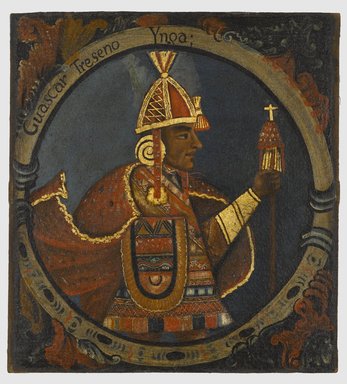Browse

| Accession # | 1995.29.13 |
|---|---|
| Culture | Peruvian |
| Artist | Unknown |
| Title | Huascar, Thirteenth Inca, 1 of 14 Portraits of Inca Kings |
| Date | Probably mid-18th century |
| Medium | Oil on canvas |
| Dimensions | 23 1/2 x 21 1/2in. (59.7 x 54.6cm) frame: 29 1/8 x 27 5/16 x 2 13/16 in. (74 x 69.4 x 7.1 cm) |
| Inscriptions | On roundel: "Guascar Treseno Ynqa;" |
| Credit Line | Dick S. Ramsay Fund, Mary Smith Dorward Fund, Marie Bernice Bitzer Fund, Frank L. Babbott Fund, gift of The Roebling Society and the American Art Council, purchased with funds given by an anonymous donor, Maureen and Marshall Cogan, Karen B. Cohen, Georgia and Michael deHavenon, Harry Kahn, Alastair B. Martin, Ted and Connie Roosevelt, Frieda and Milton F. Rosenthal, Sol Schreiber in memory of Ann Schreiber, Joanne Witty and Eugene Keilin, Thomas L. Pulling, Roy J. Zuckerberg, Kitty and Herbert Glantz, Ellen and Leonard L. Milberg, Paul and Thérèse Bernbach, Emma and J. A. Lewis, Florence R. Kingdon |
| Location | Visible Storage: Case 24, Screen A (Paintings) |
| Description | Portrait of Huascar, the Thirteenth Inca King, dressed in the finery of his office and holding a staff in his left hand and a shield in his right. This portrait is part of a series of 14 Inca King portraits that is based on the engraving by Antonio de Herrera, which in turn is based on a painted prototype (see Converging Cultures, 1996, p. 239). |
Curatorial Remarks: Although indigenous people ranked below Spaniards in Spanish America’s social order, direct descendants of pre-Hispanic nobility were afforded certain political privileges, including the right to hold office in local government. In order to legitimize claims to noble lineage in the viceroyalty of Peru, members of the Inca elite often conspicuously displayed in their homes Europeanized portraits of their ancestors, the fourteen ancient Andean rulers.
The Inca had no pictorial portraiture tradition before the conquest. Soon after European contact, however, series of Inca kings painted by local artists in European portrait styles started to appear in indigenous and Creole inventories. This bust-length portrait series is based on a 1615 Spanish engraving (see illustration).
Aunque los indígenas estaban por debajo de los españoles en el orden social de Hispanoamérica, a los descendientes directos de la nobleza prehispánica se les permitían ciertos privilegios políticos, incluyendo el derecho de tener cargos en el gobierno local. Para legitimar la atribución de linaje noble en el virreinato del Perú, miembros de la élite inca frecuentemente exhibían en sus casas retratos europeizados de sus ancestros, los catorce gobernantes andinos.
Antes de la conquista los incas no tenían una tradición pictórica de retratos. Poco tiempo después del contacto europeo, series de retratos de los reyes incas pintados por artistas locales al estilo de los retratos europeos comenzaron a aparecer en inventarios indígenas y criollos. Esta serie de bustos pintados está basada en un grabado español de 1615 (ver ilustración).